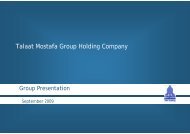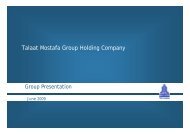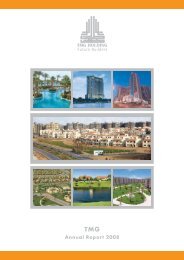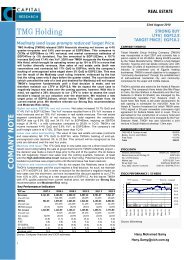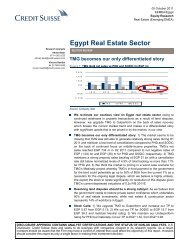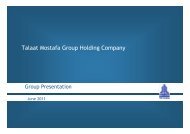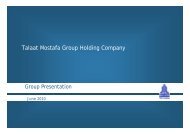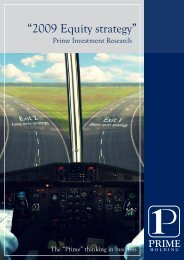Madinaty Master Plan - Talaat Moustafa Group
Madinaty Master Plan - Talaat Moustafa Group
Madinaty Master Plan - Talaat Moustafa Group
- No tags were found...
You also want an ePaper? Increase the reach of your titles
YUMPU automatically turns print PDFs into web optimized ePapers that Google loves.
Profit sharing to employees and board of directorsUnder IFRS, profit sharing to employees and board of directors is recognised when incurred in the income statement(using the accrual basis of accounting). Under EAS, profit sharing to employees and board of directors is recognisedas a dividend distribution through equity and as a liability when approved by the relevant company’s shareholdersmeeting.ProvisionsUnder IFRS, the amount of a provision shall be the present value of the expenditures expected to be required to settlethe obligation. Provisions are presented either as a current or a non-current liability. Provisions are discounted at apre-tax rate if the effect of discounting is material. This discount rate reflects the time value of money and the risksspecific to the liability, unless the future cash flows are adjusted for these risks. The amount of provision shall be thepresent value of the expenditures expected to be required to settle the obligation. Provisions are presented either as acurrent or a non-current liability.Under EAS, there is no specific standard dealing with provisions. According to EAS 1 provisions are classified ascurrent liabilities regardless of the timing of settlement of related expenditures pursuant to the model financialstatements included in EAS 1 “Financial Statements Presentation”.InvestmentsUnder IFRS, investments are classified in the following categories: financial assets at fair value through profit orloss, loans and receivables, held-to-maturity investments, and available-for-sale financial assets. Financial assets atfair value through profit or loss has two sub-categories: financial assets held for trading, and those designated at fairvalue through profit or loss at inception. Assets in this category are classified as current assets if they are either heldfor trading or are expected to be realised within 12 months of the balance sheet date. Available-for-sale financialassets are non-derivatives that are either designated in this category or not classified in any of the other categories.They are included in non-current assets unless management intends to dispose of the investment within 12 monthsof the balance sheet date. Available-for-sale financial assets and financial assets at fair value through profit or lossare subsequently carried at fair value. Realised and unrealised gains and losses arising from changes in the fair valueof the “financial assets at fair value through profit or loss” category are included in the income statement in theperiod in which they arise. Unrealised gains and losses arising from changes in the fair value of non-monetarysecurities classified as available-for-sale are recognised in equity. When securities classified as available-for-saleare sold or impaired, the accumulated fair value adjustments are included in the income statement as gains andlosses from investment securities.Under EAS investments are classified under two main categories: (a) subsidiaries/associates and (b) otherinvestments. Investment in subsidiaries/associates are accounted for using the equity method of accounting ifthe investment is classified as long term and is measured at cost if classified as short term. Other investments has twosub-categories: (a) long term investments which includes available for sale investments and investments held tomaturity and (b) short term investments which are measured either at fair value or the lower of cost or market value.Available for sale investments are measured at fair value and changes therein are recognized either in the incomestatement or directly in equity. Under EAS available for sale investments may also be measured at cost or the lowerof cost or market value. Investments held to maturity are measured at amortised cost. Effective 1 January 2007, thereare no differences between EAS and IFRS with respect to investments.35



